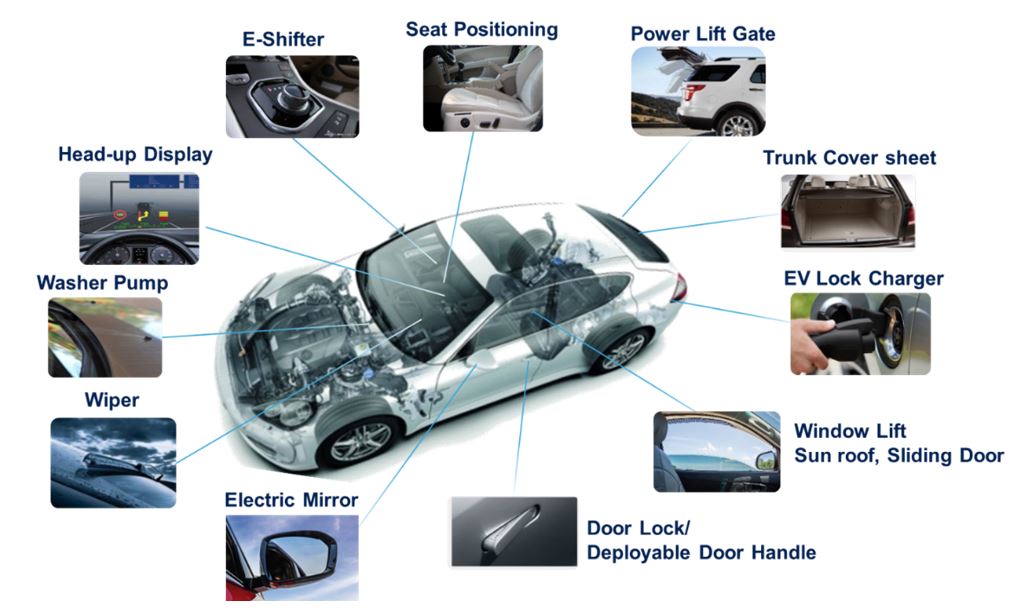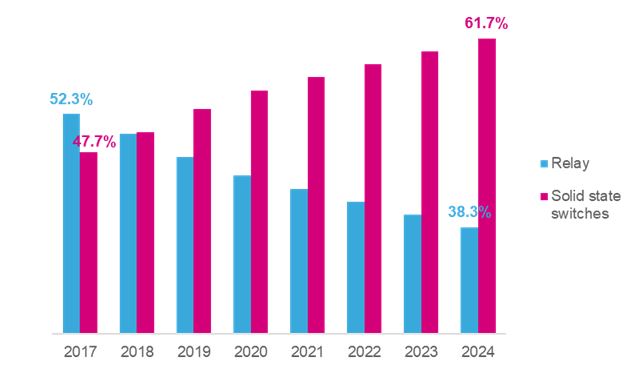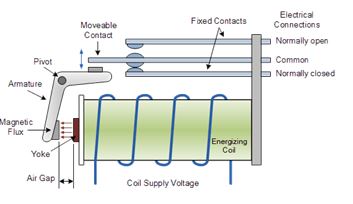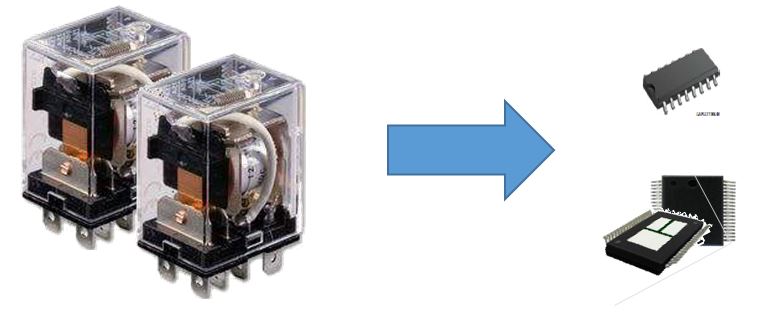Subscribe to EDOM TECH Newsletter
2019/04/15
DC Motors trends in automotive body electronics
Writer: STMicroelectronics, Miccoli Leonardo Agatino
Abstract
The content of electronic in automotive systems is constantly growing, sustained by an increasing request of automation, enhanced safety, power optimization and quality feelings. In this context the number of application using DC motors are facing up a constant boost.
This article will analyze Market trends for automotive DC motors , and will show how Solid State Drivers (SSD) represent the preferred design architecture in terms of diagnostic capability, optimized switching time, weight saving, and (on top of all) improved reliability.
In particular will show how the new VIPower™ M0-7 H-bridge family are the best in class choice of full integrated circuits specifically designed for automotive DC motor control.
Market Trends
The annual growth rate demand of automotive DC Motor systems is estimated to be stable in the surroundings of 3.1% for next 5 years. The Body perimeter is sustained by classical application like door lock, electric mirror, seat adjustment, washer pumps, wiper, window Lift, sun roof, and sliding doors. Moreover new emerging and appealing application are facing the market, some examples are: head up display, Deployable Hand door, Power Trunk Lift, E-Shifter, EV-Lock charger.

Considering this scenario the World Wide Demand for automotive DC Motors in body domain is estimate to reach 2 Billion Unit in 2020. The share for each application is represented on below picture, all application described are in the range from 30W up to 200W.

Share of DC motors actuated by Relay vs. Silicon in Body applications
the automotive industry has seen relays as an easy and cheap solution to drive DC Motors, but the feeling is changing and nowadays car makers are considering the SSD as the more appropriate option in new application designs. Thanks to high reliability quality and enhanced diagnostic features, the SSD keep easy to implement innovative features like driving variable load profiles (e.g. Power trunk Lift Gate) or implementing controlled and smooth movements (e.g. window lift or seat adjustment), getting rid of relay switching noise and increasing luxury feeling.
On top of all, world-wide local legislations are introducing new limitation for vehicles emission of both pollutant substances and CO2, modifying cars architecture especially with regards to the supply of power loads and requiring the adoption of more efficient electronic devices. Although the new standards impacts most power-train systems, some relevant contribution comes also from car Body Control Modules (BCM).
As a results the forecast of DC motors actuated by SSD will grows with a 6.7% average growth rate in 2020-25, gaining market share vs relays adoption.

Improved Reliability leads to 10x longer operating life
Relays contacts are electrically conductive pieces of metal which touch together allowing the circuit current to flow. Typical issues of mechanical switching contact are the audible noise and the mechanical vibration perceived by final customer as unpleasant feeling (especially in switching frequency driven application). Moreover during relay switching are generated arc noises that produce Electromagnetic interference (EMI). To reduce relays switching noise are needed extra components like RC Snubber and Flywheel Diode, these extra components will have a negative impact on final architecture complexity. The mid and long term effect of electro-mechanical stress generated during switching will be a reduced contact resistance and performance, making relay unusable and shorten life. Degradation of Relays performance will lead to low reliability.
Solid State Switches has no moving parts since mechanical contacts have been replaced by power transistors: no issue of arcing contacts, magnetic fields or audible noise. The input controls are compatible with most IC logic families and needs no additional buffers, drivers or amplifiers, drastically reducing PCB complexity and Area. The results is an increased reliability level: up to 10x switching times.

Application Area saving thanks to tiny power packages
The evolution of the automotive market in the direction of autonomous driving requires the utilization of a wider and wider number of sensors as well as actuators. Considered this larger number of devices must always be housed inside the same compartments, it’s easy to understand how constraints coming from space occupation are becoming more and more stringent.

The H-bridge configuration is the typical topology used to drive bidirectional DC motor: turning on alternatively the bridge switches is it possible to control motor direction or to brake the Motor. Even if H-Bridge architecture can be easily implemented using relays, the amount of board space will be significantly reduced adopting the SSD.
Considering a typical relay footprint Area approximately of 250 mm2, the board area needed to implement an H-bridge architecture by relays will be at least 500 mm2. In Addition, the implementation of high-voltage transient suppression, system diagnostic and protection features will require additional discrete circuitry like buffers, operational amplifier and sensors. The extra components will significantly increase the final board dimension and complexity and will have adverse impact on application reliability.
Finally, the design of the board covers and enclosurs must also take care of the height of the relays leading to a typical vertical keep-out distance of 17 mm.
Thanks to the outstanding shrinking of VIPower™ M0-7 technology, The ST H-Bridge family is able to implement the complete motor drive architecture into advanced tiny power packages: SO-16N and PowerSSO-36. The reduced footprint respectively of 60mm2 and 106mm2 and the thickness under 2.5mm will allow PCB shrinkage and system weight reduction. Moreover, VIPower™ M0-7 H-bridges offer an eco-friendly product portfolio of lead-free packages ensuring outstanding thermal performance.

Switching Time and PWM control
By guiding an H-Bridge architecture, special care must be taken to avoid unwanted short-circuits between the battery line and the ground, especially during switching phases; this event is commonly defined as dynamic shoot trough. When a shout trough event occurs it will be generated an extra noise on battery line and an extra power dissipation that will reduce the system efficiency. This phenomena become more critical if the H-Bridge is driven with fast switching control like PWM signal.

PWM input signal is commonly used to control H-bridge architecture, indeed varying duty cycle it is possible to modulate motor speed and torque implementing advanced features like:
The Typical DC Motors profile has a startup phase with an inrush current 10-12 times bigger than normal Current. All electric parts must be dimensioned to sustain this high current for a short time and this will have a consistent impact on final application in terms of cable sizing, PCB area and driver capability.
Indeed relay data sheets give maximum contact ratings for resistive DC loads only, but this rating is greatly reduced for highly inductive or capacitive loads.
Driving DC Motor with a PWM signal it is possible to achieve a smooth motor start up limiting the torque. The inrush current will be reduced prolonging the motor activation phase. Driving the DC motor with a PWM signal will allow to optimize the power dissipation and to reduce cable sizing, contributing overall to weight saving.

Relay are not a suitable choice for systems requiring fast output switching, indeed the switching times are limited by mechanical tips movements that typically goes from 5ms up to 15 ms. Moreover the MCU have to implement proper logic protections to avoid unwanted cross conduction events.
The VIPower™ M0-7 H-bridges family guarantees fast switching times (1 μs typ.) that ensure a switching frequency up to 20 KHz. The Switching profiles are specifically designed to optimize EMI and to optimize switching losses. Moreover the chip embeds special protections that avoid dynamic and static cross-conduction issue. As a result the VNH7 family is designed to optimize the system efficiency.
The VIPower™ M0-7 family H-bridges for DC Motor Control
The VIPower™ M0-7 H-bridge family can be considered as the natural option for automotive DC Motor Driving, catching the increasing market request for enhanced reliability, system efficiency and luxury benefits. Thanks to the Hybrid approach the M0-7 H-bridges family is able to integrate in one single package logic functions and power structures providing a complete portfolio of full integrated and protected circuits. Thanks to the availability of different on-state resistance (from 8 mΩ up to 100 mΩ) and tiny Power Packages, they ensure flexible driving and control, covering a wide range of load conditions (from few up to 200W).

While Low and medium power devices integrate all logic function and complete power stages (including High side and Low side Power MOS), the High power devices VNHD7008AY and VNHD7012AY have a different architecture including the High side Power MOS and the Low side gate driver. Hence to complete the H-Bridge architecture are needed external Los side Power MOS (suggested ST’s STL76DN4LF7AG).
The combination of 20-kHz PWM speed control and diagnostic mechanism makes them ideal for high-end automotive applications. A very low power dissipation in standby mode (Maximum 3 μA) and an optimized switching profile during transition will keep low the power consumption of the modules in spite of the increased electronic components on board.
The integrated advanced diagnostic (Vcc voltage, Case temperature, and Current Load monitoring) and protection features (Overvoltage, Short-circuit, High temperature and Cross conduction protections) will protect both the power stage and the load without impacting on final efficiency system and guaranteeing the device will work always inside safe operating area. Moreover thanks to the OFF state diagnostic feature it is possible to monitor the Motor status during standby condition, avoiding potential damage at turn on.
The Combination of the VIPower™ M0-7 intelligent Power Switches and H-Bridges drivers inside the Body Control Modules will lead to relevant saving in terms of power dissipation, PCB Area and wires reduction. The practical results will be an increased system reliability and an estimated weight saving up to 50kg per vehicle, that will reflect in a positive impact on pollution contributing to a reduction of CO2 emissions for ICE vehicles (estimated up to 3.5g/km), and to a battery optimization and increased autonomy for BEV vehicles.
Abstract
The content of electronic in automotive systems is constantly growing, sustained by an increasing request of automation, enhanced safety, power optimization and quality feelings. In this context the number of application using DC motors are facing up a constant boost.
This article will analyze Market trends for automotive DC motors , and will show how Solid State Drivers (SSD) represent the preferred design architecture in terms of diagnostic capability, optimized switching time, weight saving, and (on top of all) improved reliability.
In particular will show how the new VIPower™ M0-7 H-bridge family are the best in class choice of full integrated circuits specifically designed for automotive DC motor control.
Market Trends
The annual growth rate demand of automotive DC Motor systems is estimated to be stable in the surroundings of 3.1% for next 5 years. The Body perimeter is sustained by classical application like door lock, electric mirror, seat adjustment, washer pumps, wiper, window Lift, sun roof, and sliding doors. Moreover new emerging and appealing application are facing the market, some examples are: head up display, Deployable Hand door, Power Trunk Lift, E-Shifter, EV-Lock charger.

Considering this scenario the World Wide Demand for automotive DC Motors in body domain is estimate to reach 2 Billion Unit in 2020. The share for each application is represented on below picture, all application described are in the range from 30W up to 200W.

Share of DC motors actuated by Relay vs. Silicon in Body applications
the automotive industry has seen relays as an easy and cheap solution to drive DC Motors, but the feeling is changing and nowadays car makers are considering the SSD as the more appropriate option in new application designs. Thanks to high reliability quality and enhanced diagnostic features, the SSD keep easy to implement innovative features like driving variable load profiles (e.g. Power trunk Lift Gate) or implementing controlled and smooth movements (e.g. window lift or seat adjustment), getting rid of relay switching noise and increasing luxury feeling.
On top of all, world-wide local legislations are introducing new limitation for vehicles emission of both pollutant substances and CO2, modifying cars architecture especially with regards to the supply of power loads and requiring the adoption of more efficient electronic devices. Although the new standards impacts most power-train systems, some relevant contribution comes also from car Body Control Modules (BCM).
As a results the forecast of DC motors actuated by SSD will grows with a 6.7% average growth rate in 2020-25, gaining market share vs relays adoption.

Improved Reliability leads to 10x longer operating life
Relays contacts are electrically conductive pieces of metal which touch together allowing the circuit current to flow. Typical issues of mechanical switching contact are the audible noise and the mechanical vibration perceived by final customer as unpleasant feeling (especially in switching frequency driven application). Moreover during relay switching are generated arc noises that produce Electromagnetic interference (EMI). To reduce relays switching noise are needed extra components like RC Snubber and Flywheel Diode, these extra components will have a negative impact on final architecture complexity. The mid and long term effect of electro-mechanical stress generated during switching will be a reduced contact resistance and performance, making relay unusable and shorten life. Degradation of Relays performance will lead to low reliability.
Solid State Switches has no moving parts since mechanical contacts have been replaced by power transistors: no issue of arcing contacts, magnetic fields or audible noise. The input controls are compatible with most IC logic families and needs no additional buffers, drivers or amplifiers, drastically reducing PCB complexity and Area. The results is an increased reliability level: up to 10x switching times.

Application Area saving thanks to tiny power packages
The evolution of the automotive market in the direction of autonomous driving requires the utilization of a wider and wider number of sensors as well as actuators. Considered this larger number of devices must always be housed inside the same compartments, it’s easy to understand how constraints coming from space occupation are becoming more and more stringent.

The H-bridge configuration is the typical topology used to drive bidirectional DC motor: turning on alternatively the bridge switches is it possible to control motor direction or to brake the Motor. Even if H-Bridge architecture can be easily implemented using relays, the amount of board space will be significantly reduced adopting the SSD.
Considering a typical relay footprint Area approximately of 250 mm2, the board area needed to implement an H-bridge architecture by relays will be at least 500 mm2. In Addition, the implementation of high-voltage transient suppression, system diagnostic and protection features will require additional discrete circuitry like buffers, operational amplifier and sensors. The extra components will significantly increase the final board dimension and complexity and will have adverse impact on application reliability.
Finally, the design of the board covers and enclosurs must also take care of the height of the relays leading to a typical vertical keep-out distance of 17 mm.
Thanks to the outstanding shrinking of VIPower™ M0-7 technology, The ST H-Bridge family is able to implement the complete motor drive architecture into advanced tiny power packages: SO-16N and PowerSSO-36. The reduced footprint respectively of 60mm2 and 106mm2 and the thickness under 2.5mm will allow PCB shrinkage and system weight reduction. Moreover, VIPower™ M0-7 H-bridges offer an eco-friendly product portfolio of lead-free packages ensuring outstanding thermal performance.

Switching Time and PWM control
By guiding an H-Bridge architecture, special care must be taken to avoid unwanted short-circuits between the battery line and the ground, especially during switching phases; this event is commonly defined as dynamic shoot trough. When a shout trough event occurs it will be generated an extra noise on battery line and an extra power dissipation that will reduce the system efficiency. This phenomena become more critical if the H-Bridge is driven with fast switching control like PWM signal.

PWM input signal is commonly used to control H-bridge architecture, indeed varying duty cycle it is possible to modulate motor speed and torque implementing advanced features like:
- Anti-Pinch function
- smooth movement at start and stop to increase quality feeling
- Stall condition Control
- Motor speed regulation independently from battery voltage
- Reduced Start Up Inrush current
The Typical DC Motors profile has a startup phase with an inrush current 10-12 times bigger than normal Current. All electric parts must be dimensioned to sustain this high current for a short time and this will have a consistent impact on final application in terms of cable sizing, PCB area and driver capability.
Indeed relay data sheets give maximum contact ratings for resistive DC loads only, but this rating is greatly reduced for highly inductive or capacitive loads.
Driving DC Motor with a PWM signal it is possible to achieve a smooth motor start up limiting the torque. The inrush current will be reduced prolonging the motor activation phase. Driving the DC motor with a PWM signal will allow to optimize the power dissipation and to reduce cable sizing, contributing overall to weight saving.

Relay are not a suitable choice for systems requiring fast output switching, indeed the switching times are limited by mechanical tips movements that typically goes from 5ms up to 15 ms. Moreover the MCU have to implement proper logic protections to avoid unwanted cross conduction events.
The VIPower™ M0-7 H-bridges family guarantees fast switching times (1 μs typ.) that ensure a switching frequency up to 20 KHz. The Switching profiles are specifically designed to optimize EMI and to optimize switching losses. Moreover the chip embeds special protections that avoid dynamic and static cross-conduction issue. As a result the VNH7 family is designed to optimize the system efficiency.
The VIPower™ M0-7 family H-bridges for DC Motor Control
The VIPower™ M0-7 H-bridge family can be considered as the natural option for automotive DC Motor Driving, catching the increasing market request for enhanced reliability, system efficiency and luxury benefits. Thanks to the Hybrid approach the M0-7 H-bridges family is able to integrate in one single package logic functions and power structures providing a complete portfolio of full integrated and protected circuits. Thanks to the availability of different on-state resistance (from 8 mΩ up to 100 mΩ) and tiny Power Packages, they ensure flexible driving and control, covering a wide range of load conditions (from few up to 200W).

While Low and medium power devices integrate all logic function and complete power stages (including High side and Low side Power MOS), the High power devices VNHD7008AY and VNHD7012AY have a different architecture including the High side Power MOS and the Low side gate driver. Hence to complete the H-Bridge architecture are needed external Los side Power MOS (suggested ST’s STL76DN4LF7AG).
The combination of 20-kHz PWM speed control and diagnostic mechanism makes them ideal for high-end automotive applications. A very low power dissipation in standby mode (Maximum 3 μA) and an optimized switching profile during transition will keep low the power consumption of the modules in spite of the increased electronic components on board.
The integrated advanced diagnostic (Vcc voltage, Case temperature, and Current Load monitoring) and protection features (Overvoltage, Short-circuit, High temperature and Cross conduction protections) will protect both the power stage and the load without impacting on final efficiency system and guaranteeing the device will work always inside safe operating area. Moreover thanks to the OFF state diagnostic feature it is possible to monitor the Motor status during standby condition, avoiding potential damage at turn on.
The Combination of the VIPower™ M0-7 intelligent Power Switches and H-Bridges drivers inside the Body Control Modules will lead to relevant saving in terms of power dissipation, PCB Area and wires reduction. The practical results will be an increased system reliability and an estimated weight saving up to 50kg per vehicle, that will reflect in a positive impact on pollution contributing to a reduction of CO2 emissions for ICE vehicles (estimated up to 3.5g/km), and to a battery optimization and increased autonomy for BEV vehicles.






